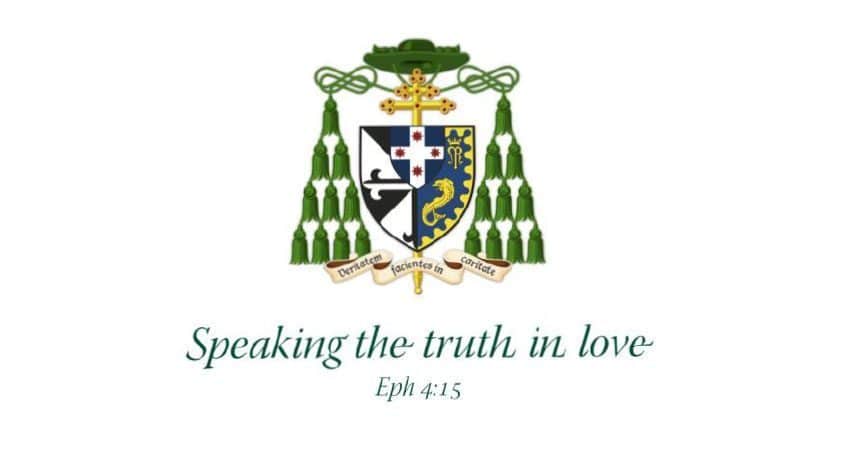Homily for the Australia Day Mass

Chapel of Our Lady of the Rosary and St Peter Chanel, Domus Australia, 26 January 2024
The idea of Terra Australis Incognita, a huge and mysterious southern continent, was born of two ideas in the ancient world.[1] First, it was hypothesised that if the world was round—as most experts in the ancient world agreed it was—then to keep the balance there would likely be a great land mass in the Southern hemisphere as big as Eurasia in the North, sustaining a large antipodean population.[2] A second assumption was that there were isthmuses connecting Africa, Asia and South America to the great south land.[3] Throughout the Renaissance, Terra Australis Incognita nourished the imaginations of geographers, explorers, conquistadors and empire-builders, as well as authors of fantastical travelogues. Renaissance cartographers made world maps with a hypothetical southern land mass no one had yet seen: Joseph Hall’s Mundus alter et idem of 1607 even has Terra Australis divided into a series of burlesque kingdoms.[4]
The mid-sixteenth century floor-to-ceiling world maps in the Terza Loggia of the Apostolic Palace have a large blank space at the bottom for future generations to fill in; and, in the meantime, waves, ships and sea-monsters surround the void, as well as a bit of Antarctica near South America and a few islands off Asia.
While those from the North fantasised about the lands of the South, Aboriginal and Torres Strait Islanders had been living on continental Australia for upwards of 60,000 years.[5] I remember a banner hanging outside the State Library in Sydney that celebrated the Gweagal Aboriginals who discovered James Cook wandering round Kamay or Botany Bay in April 1770. After striking South-Eastern Australia, Cook surveyed most of the East coast up to Cape York, thereby completing the map of Australia and settling once and for all that it was smaller than the ancients had imagined and discontinuous with Antarctica, Asia and Africa. Cook’s compatriot, the pirate-explorer William Dampier, had already landed on the north-western coast a century before (1688). But the Dutch got there first amongst the Europeans: Abel Tasman had been to what we now call Tasmania in 1642 and mapped much of the mainland; the very lost François Thijssen hit the south coast of Australia in 1627; and the equally bamboozled Dirk Hartog an island off Shark Bay in Western Australia in 1616. But it was Willem Janszoon who made the first documented European landing in Australia, on the Western shore of Cape York in 1606.
In the great European race to “discover” Terra Australis, a Portuguese navigator named Pedro de Queirós arrived in the region at the same time as Janszoon. With the blessing of Pope Clement VIII, he was leading a Spanish expedition to the Pacific in the hope of claiming the great south land for Christ, his Church and the Catholic kings.[6] Striking land at last he named the bay Vera Cruz (True Cross), built a temporary chapel of Our Lady, and organised for Mass to be celebrated on the Feast of Pentecost.[7] Believing he had found the fabled southern continent, he now named it all “Terra Australis del Espiritu Santo” (the Southern Land of the Holy Spirit). But as luck would have it, he had missed mainland Australia by 3,600 km, landing at what we now call Vanuatu!
Although he hadn’t found Australia, Queirós managed to nail down its name and his dream that the new continent might avoid the vices of the Old World, with its greed, violence and enslavement was very genuine.[8] This inspired James McAuley’s 1964 narrative poem, Captain Quiros, exploring the motivations of the Portuguese adventurer and pining for an Australian character marked by more than just establishment Anglo-Protestantism.[9] In McAuley’s estimation, Queirós wanted Australia to be a land of piety and pity, not just named for the Holy Spirit but where that Spirit actually inspired the society that evolved there.
What would such an Australia look like? Would it be a restful place, as in Isaiah’s dream, a garden paradise, fertile and fair, peaceful and secure (Isa 32:15-18)? Or would it be a more active space, full of preachers and prophets, healers and doers, as in St Paul’s epistle (1Cor 12:4-11)? Can one place be both or are both fantastical illusions, like the dream of the Great South Land?
Well, this much is clear: since the Fall, no land, no people, has escaped the destructive effects of sin. The land where the Prince of Peace was born—the zero point of salvation—has rarely been free of suffering: at present the strife is even worse than normal. If that is true even in the ‘Holy’ Land, nowhere will be free from human frailty and loss till God’s kingdom come… But if utopian promises of earthly paradises always disappoint, still there is better and worse. Australia could be better, and it could be worse. Some of that is history, geography, world politics—things we can do little about. But much of it is a matter of character, values, culture—things citizens can make or break.
If we truly trust in God as a Father, who in the words of our Gospel (Lk 12:22-32), cares far more for us than for the kookaburras and wattles; if we really believe in His Son, whose Southern Cross hangs in the night sky above Australia as a promise of salvation, and whose Gospel has informed so much of our national institutions and values; if we are genuinely inspired by that Holy Spirit whose Great South Land is ours also—then nothing need shake our confidence and determination to keep making our nation better. No failure as small as caring too much about food or clothes, no failure as big as ‘discovering’ the wrong land mass or dispossessing those who got there first: no human weakness or tragedy can separate us from the love of God. Come Holy Spirit of the Great South Land. Come fill the hearts of the faithful and all its inhabitants. Come kindle in them the fire of your love. Send forth your grace that Australians might be re-created. Come renew the face of the earth.
[1] Corin Braga, “The invention of Terra Australis Incognita” https://exhibits.stanford.edu/global-imaginary/feature/the-invention-of-terra-australis-incognita
[2] The historian Gunter Schider states “It was felt that an undiscoverd southern continent had to exist because the known land masses of the southern hemisphere were not sufficient to balance those of the northern half of the globe…” https://christiantoday.com.au/news/person-of-faith-pedro-ferdinand-de-quiros.html
[3] https://exhibits.stanford.edu/global-imaginary/feature/the-invention-of-terra-australis-incognita
[4] Braga, “The invention of Terra Australis Incognita”.
[5] The Australian Institute of Aboriginal and Torres Strait Islander Studies puts it at “upwards of 60,000 years”; the National Museum of Australia at “at least 65,000 years”; other scholars at “50,000 years ago” (https://newsroom.unsw.edu.au/news/science-tech/when-did-aboriginal-people-first-arrive-australia) or “between 50,000 and 120,000 years” (http://www.workingwithindigenousaustralians.info/content/History_2_60,000_years.html).
[6] The Australian Manning Clark referred to Quiros as ‘one of the flowers of the Catholic reformation, part of that movement of religious idealism and of missionary fervour which strengthened the church after the disasters of Luther and Calvin” https://christiantoday.com.au/news/person-of-faith-pedro-ferdinand-de-quiros.html
[7] A thorough account of Quiros’s travels can be found in The Voyages of Pedro Fenandez de Quiros, 1595-1606, trans and edited by Sir Clements Markham Vol 1 (The Hakluyt Society: London, 1855). https://www.gutenberg.org/files/41200/41200-h/41200-h.htm#bk3
[8] https://quirosonline.com/about/
[9] See Nicholas Birns and Rebecca McNeer, A Companion to Australian Literature Since 1900 (Camden House, 2007), 182-3.
Introduction to the Australia Day Mass – Chapel of Our Lady of the Rosary and St Peter Chanel, Domus Australia, 26 January 2024
Welcome to the Chapel of Our Lady of the Rosary and St Peter Chanel here at Domus Australia for our 2024 celebration of Australia Day.
I acknowledge Most Rev. Richard Umbers, Auxiliary Bishop of Sydney; and several concelebrating priests. I greet leaders of several religious congregations, and other clergy, religious, seminarians and lay faithful working or studying here in Rome.
I salute Her Excellency Chiara Porro, Ambassador of Australia to the Holy See; His Excellency Joseph Donnelly, Ambassador of the United States; His Excellency Frances Collins, Ambassador of the Republic of Ireland; His Excellency Archduke Eduard Hapsburg the Ambassador of Hungary; along with other diplomatic staff and honoured guests.
A very big thank you to Very Rev. Joseph Hamilton, the recently appointed Rector here at Domus Australia, and General Manager Signor Fabrizio Petrocchi for their customary hospitality.
Much has changed since the last time I celebrated the Australia Day Mass here in Rome two years ago, including the passing of Pope Emeritus Benedict XVI who blessed and opened Domus Australia and George Cardinal Pell who established it as a dedicated Australian pilgrim house in the eternal city. Gathering here we naturally give thanks to God for their lasting contributions to Church and society in Australia and the Church universal. And on this Australia Day we entrust our country to God’s mercy and grace as we say: I confess….

